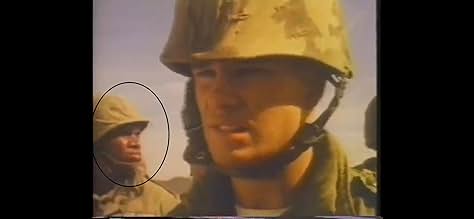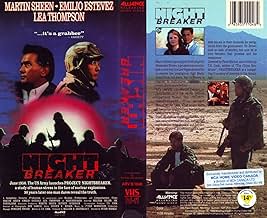IMDb-BEWERTUNG
6,3/10
513
IHRE BEWERTUNG
Füge eine Handlung in deiner Sprache hinzuDr. Brown thinks back on his 30+ years working as an Army shrink in Nevada in 1956, when U.S. soldiers were exposed to A-bomb radiation.Dr. Brown thinks back on his 30+ years working as an Army shrink in Nevada in 1956, when U.S. soldiers were exposed to A-bomb radiation.Dr. Brown thinks back on his 30+ years working as an Army shrink in Nevada in 1956, when U.S. soldiers were exposed to A-bomb radiation.
- Auszeichnungen
- 2 Gewinne & 3 Nominierungen insgesamt
Handlung
WUSSTEST DU SCHON:
- WissenswertesCalled "Advance to Ground Zero" in Australia.
- VerbindungenReferenced in There's Nothing Out There (1991)
Ausgewählte Rezension
Scarier than cannibalistic zombies or mutant rats, this is a fictional story built around a real incident.
In the early years of the atomic age, Emilio Estevez is a scientist working for the Atomic Energy Commission and is involved in testing bombs in Nevada. We don't hear much about it, but man were those tests badly bungled. These were above-ground tests of dirty devices. Sheen and some airborn troops are exposed to the blasts, first from far away, then closer. The last one is too close. We don't know it until we see the trucks delivering the troops to their positions. The men are hustled off and the trucks zoom away in a cloud of dust. The dugouts to have been provided for the men are not there. One of them looks up at the tower. In previous tests we've seen the tower as no more than a spike on the distant desert horizon. This time the monster is close enough to make out details of its structure. "Wow," says the soldier, "What's the range on THAT one?" No answer is forthcoming. Later we learn the records show the distance as twenty miles, about nineteen miles extra thrown in to cover someone's behind.
In the early tests a lot of colorful footage was shot of our brave soldiers emerging from their trenches and marching towards the demonic cauliflower cloud. It's hard to imagine why they were there in the first place except to inoculate the public to the idea of atomic war. See them walk into the dust? They're as safe as in their mother's arms. Nothing to be afraid of. I once asked a professor of chemistry who was familiar with the outlines of the testing program whether the authorities realized the danger they were putting the troops in, and he replied, "They knew." The movie doesn't mention it, but the troops weren't the only people put at risk. The detonations raised clouds of pretty tangerine dirt that drifted across the sky over southern Utah, bringing many of the resident of St. George out to view the colorful sunsets and breathe the fallout, with the expectable results.
The drama is relatively low key, especially for a TV movie, far less flamboyant than, say, "Fat Man and Little Boy." The most touching scene in the movie, probably, is when a handful of soldiers are invited to a party given by some young women. But when they return from one of the tests, they are denied entrance to the party because they may have been irradiated and might be dangerous to be around. Nobody goes into fits of screaming anger. It's not that kind of story. All we have is a rather long shot of the disappointed men standing wordlessly at parade rest outside the screen door.
The photography is particularly good. Most of the outdoor scenes are tinted a jaundiced yellow, as if already poisoned. The colors are all earth tones, but not depressing in themselves. And the desert is not ominous in any way.
The earth is not sentient or smart, except that part of it that we humans represent.
The film has no zombies or man-eating fish, but it's scarier than you might imagine. The most frightening thing about it is not the vastness of the desert, nor even the bomb itself, but rather the minds that put the bomb where it is, and the troops where they were, and then decided the bomb should explode. What were those minds thinking? We've never had an explanation and the movie gives us none. It's unlikely that we'll find out whether it was by accident or design that these lives were ruined.
PS: I just viewed this again for the first time since its release and expected to find the message overstated this time, but was wrong. Now that I'm more mature and a little more familiar with death in its more prosaic forms I find the movie more powerful than ever. It took courage to make it.
In the early years of the atomic age, Emilio Estevez is a scientist working for the Atomic Energy Commission and is involved in testing bombs in Nevada. We don't hear much about it, but man were those tests badly bungled. These were above-ground tests of dirty devices. Sheen and some airborn troops are exposed to the blasts, first from far away, then closer. The last one is too close. We don't know it until we see the trucks delivering the troops to their positions. The men are hustled off and the trucks zoom away in a cloud of dust. The dugouts to have been provided for the men are not there. One of them looks up at the tower. In previous tests we've seen the tower as no more than a spike on the distant desert horizon. This time the monster is close enough to make out details of its structure. "Wow," says the soldier, "What's the range on THAT one?" No answer is forthcoming. Later we learn the records show the distance as twenty miles, about nineteen miles extra thrown in to cover someone's behind.
In the early tests a lot of colorful footage was shot of our brave soldiers emerging from their trenches and marching towards the demonic cauliflower cloud. It's hard to imagine why they were there in the first place except to inoculate the public to the idea of atomic war. See them walk into the dust? They're as safe as in their mother's arms. Nothing to be afraid of. I once asked a professor of chemistry who was familiar with the outlines of the testing program whether the authorities realized the danger they were putting the troops in, and he replied, "They knew." The movie doesn't mention it, but the troops weren't the only people put at risk. The detonations raised clouds of pretty tangerine dirt that drifted across the sky over southern Utah, bringing many of the resident of St. George out to view the colorful sunsets and breathe the fallout, with the expectable results.
The drama is relatively low key, especially for a TV movie, far less flamboyant than, say, "Fat Man and Little Boy." The most touching scene in the movie, probably, is when a handful of soldiers are invited to a party given by some young women. But when they return from one of the tests, they are denied entrance to the party because they may have been irradiated and might be dangerous to be around. Nobody goes into fits of screaming anger. It's not that kind of story. All we have is a rather long shot of the disappointed men standing wordlessly at parade rest outside the screen door.
The photography is particularly good. Most of the outdoor scenes are tinted a jaundiced yellow, as if already poisoned. The colors are all earth tones, but not depressing in themselves. And the desert is not ominous in any way.
The earth is not sentient or smart, except that part of it that we humans represent.
The film has no zombies or man-eating fish, but it's scarier than you might imagine. The most frightening thing about it is not the vastness of the desert, nor even the bomb itself, but rather the minds that put the bomb where it is, and the troops where they were, and then decided the bomb should explode. What were those minds thinking? We've never had an explanation and the movie gives us none. It's unlikely that we'll find out whether it was by accident or design that these lives were ruined.
PS: I just viewed this again for the first time since its release and expected to find the message overstated this time, but was wrong. Now that I'm more mature and a little more familiar with death in its more prosaic forms I find the movie more powerful than ever. It took courage to make it.
- rmax304823
- 3. Mai 2004
- Permalink
Top-Auswahl
Melde dich zum Bewerten an und greife auf die Watchlist für personalisierte Empfehlungen zu.
Details
Zu dieser Seite beitragen
Bearbeitung vorschlagen oder fehlenden Inhalt hinzufügen

Oberste Lücke
By what name was Operation Nightbreaker (1989) officially released in Canada in English?
Antwort
































